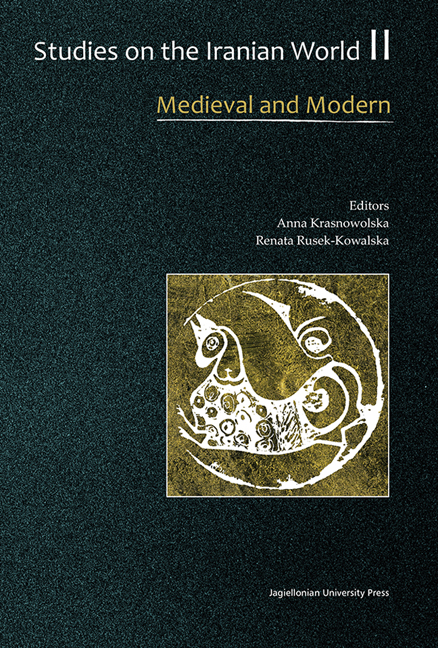Foreword
Published online by Cambridge University Press: 12 January 2018
Summary
We are pleased to present the second of the two volumes of the ECIS7 proceedings dedicated to studies on the Medieval and Modern Iranian World.
The papers in this volume were presented in Cracow in September 2011 on the occasion of the Seventh European Conference of Iranian Studies (ECIS7). European Conferences of Iranian Studies (ECIS) are organized every four years under the auspices of the Societas Iranologica Europaea (SIE), a learned international society, which was founded in 1983, with the aim of promoting, developing and supporting Ancient, Middle and Modern Iranian Studies in all subject areas of these fields, including philology, linguistics, literature, history, religions, art, archaeology, philosophy, ethnology, geography and human sciences.
Following the previous SIE conferences, which were held in Turin (1987), Bamberg (1991), Cambridge (1995), Paris (1999), Ravenna (2003), and Vienna (2007), the seventh conference in 2011 was organized by the Iranian Studies Department of the Jagiellonian University in Cracow, Poland. Over 300 participants, not only from Europe, but also from Asia, North America and Australia (30 countries altogether) made the conference truly international in scope and representative, at least to some degree, of the current trends prevailing in the field of Iranian studies.
For publication purposes, the editors have decided on a traditional chronological division of the papers into two volumes: the Pre-Islamic period and the Classical and Modern periods. The latter one, Studies on the Iranian World: Medieval and Modern, was supposed to cover the span of time from the beginnings of Islam to the present day; yet, as can be seen, the focus of the contributors was, with a few exceptions, on the centuries from the Mongol period on, and the majority of fields are dominated by contemporary issues. The papers included in the second volume have been arranged in six thematic groups: linguistics, literature, religion, history, art, social sciences and culture. The variety of themes presented in the volume reveals, to some extent, new tendencies in Iranian studies. Its content shows how the range of interest in Iranology is broadening, exceeding far beyond the borders of ‘high culture’. Classical Persian literature, once the most important field of Iranian studies, is poorly represented (as it was at the Conference), film raises no less interest than modern literature, and linguistics is looking for new methods and approaches.
- Type
- Chapter
- Information
- Studies on the Iranian WorldMedieval and Modern, pp. 9 - 10Publisher: Jagiellonian University PressPrint publication year: 2015

